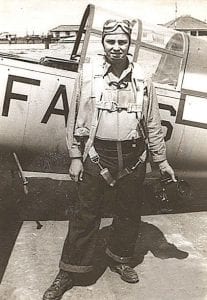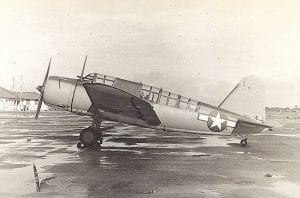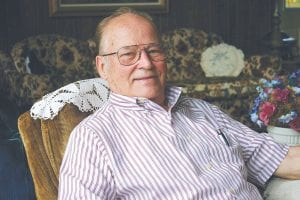Many Cook County residents know Robert R. “Bob” McClanahan, from his career at Erie Mining Company, from his stint as a Cook County Commissioner, or as the man who built a bowling alley in Grand Marais. However, they may not realize that he also had a full career in the ever-changing military aviation field.
McClanahan graduated from high school in Des Moines, Iowa, in the waning years of the Great Depression. He attended vocational school, training in the National Youth Administration (NYA) to become a tool and die maker and machinist. When he finished his training, he went to work in the Bremerton Shipyards in Washington State. Looking for adventure, he decided to return home to join the US Navy—the Aviation branch.
He completed basic training at Great Lakes Naval Training Station near Chicago and then underwent Naval Air Training in Chicago. Upon completion of his training, he was sent overseas to the Atlantic Fleet to participate in anti-submarine warfare. “Needless to say, the Germans had them all over the Atlantic and Caribbean, also off the coast of Africa,” recalled McClanahan.

Below left: Airman McClanahan at Mossio, Brazil. He is ready for flight, wearing a parachute and life vest and holding his K-16 recording camera.
He shipped out of Norfolk, Virginia aboard a ship that evaded German U-Boats by traveling to New York, the African Coast, and Trinidad, winding up in South America. He worked as a Plane Captain at bases in Natelle, Mossio, and Rio de Janeiro, Brazil. As Plane Captain, McClanahan maintained and flew in the rear seat of the plane. Looking at photos of the OS 2U Kingfisher he flew in, McClanahan chuckles, “As Plane Captain, I was co-pilot, gunner, cameraman, radio operator, etc. I was jack of all trades— master of none.”
The air base at Rio de Janeiro was especially challenging. The base had water on one side, with a 12-15 foot drop-off on the side of the runway. “There was no second chance taking off there—it was water or a wall if you messed up!” recalls McClanahan.
McClanahan did enjoy seeing the sights in South America, including the Southern Cross, the amazing Sugarloaf Cable Car in Rio, and beautiful Christ the Redeemer statue overlooking Rio de Janeiro.

Below: The OS2V airplane on which McClanahan served as Plane Captain. He was co-pilot, gunner, cameraman, mechanic—and jack-of-all-trades.
He also said his squadron conducted some interesting training, practicing fighting fires in mock plane crashes, rescuing a dummy pilot. Again, McClanahan chuckles, “I think the Ensign was actually an arsonist!”
He also laughs at one of his only experiences in the Navy in a boat. He and another airman had to make a delivery to a ship, traveling from Natelle to Recife in a battle boat, encountering four-foot swales. As they approached the large ship, the sailors on board signaled their docking instructions with semaphore flags. “The Chief asked, ‘Mac, do you remember semaphore?’ I told him, ‘It looks like a blur of flags to me.’ ”
The sailors then tried Morse code via a signal lamp. The Chief asked McClanahan how he proficient he was reading code on the blinker. McClanahan laughs, “I said it’s a nice light!”
The sailors finally figured out that McClanahan and the Chief were “flyboys” and they sent a gunner out in a little boat to get them aboard.
After serving several years in South America, about the time the Germans surrendered, McClanahan was transferred back to the US, where he was assigned to an F4U Corsair Squadron at Chanute Air Base in Illinois. There he prepared to be sent to fight in the war against Japan. However, he said, “We dropped the A-Bomb—and I was discharged.”
Upon the surrender of Japan, McClanahan was assigned to a Naval Reserve unit. He decided to attend the University of Minnesota as a Reserve Officer Training Cadet. During his training, the organization for which he served was changed from the Naval Air Corps to the US Air Force.
McClanahan signed up with the Minnesota Air National Guard in 1950—just in time to be recalled to the Korean conflict. His travels to Korea included some enjoyable sights— he was able to spend some time in California on his way overseas and had some rest and relaxation time in Japan. He has a funny photo of himself riding in a rickshaw.
His primary job in Tageu, Korea, was in the radio section, operating and supervising the Teletype. Someone had to be in constant communication, so the radio equipment was next to his bunk 24 hours a day.
McClanahan was not impressed with the aircraft used by the US Air Force in Korea—the F84 Thunder Jet. “We called them ‘blunder jets,'” explains McClanahan. “They were ground-loving things.”
He said the F84s carried a 500- pound bomb under each wing. “If the pilot didn’t get the nose up right, you ended up right in the rice paddies!”
Therunway at the Korean base was also a challenge; it was portable, made of steel planking.
There are many memories of Korea he would rather not talk about. He recalls visiting Hiroshima in Japan, seeing all that was left standing, a twostory elevator shaft. He remembers serving as Acting Commander in an office built of sandbags, which was barraged daily until the US took domination of airspace.
He also remembers the frustration of training new airmen. “No matter what phase in war, you always seem to be teaching new guys,” he says.
While in Korea, he decided it was time for him to “settle down.” He recalled skiing at Lutsen Mountains during his college days, so he chose Grand Marais to be his home when he returned to the states.
In 1953, the hostilities had decreased enough that his services were no longer needed and he was released to come home, happy to once again be a civilian. He came to the North Shore and found work at the Erie Mining Company. He was also fortunate to meet Hazel Berglund, the love of his life. They have been married 46 years last June. They built their home on the shore of Lake Superior, where they raised their two children, Colleen and Robert and where they continue to spend time with their six grandchildren.
Where Bob has continued to be a jack-of-all-trades!



Loading Comments